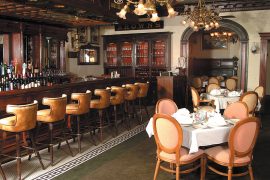By Brenda Suttle
HQ 6 | WINTER 1991
Education has become a buzzword in West Virginia and in the nation as a whole. The state of our educational system is constantly criticized and calls for reform abound. As we struggle to devise solutions and make improvements, we might find encouragement by reflecting on some of the positive accomplishments of our schools.
Huntington has only to look as far as Eighth Street and Ninth Avenue to find a school that has graduated more than its share of high achievers. Huntington High School has been providing students with quality education for more than a century.
The roots ofHuntington High School can be traced to the late 1800s. During that era, it was common practice to use free space in city halls, churches and other buildings as classrooms. As the population of the city grew, it became apparent a more organized approach to education was needed.
In 1889, Naomi Everett was instrumental in bringing some needed structure to Huntington’s educational system. She developed and implemented a high school curriculum. The following spring, Huntington High held its first graduation ceremony. The class of 1890 consisted of two people – Chester Sanborn and Erna Wells.
At the time of its inception, Huntington High had a relatively small enrollment. Everett and her students were assigned a couple of rooms in the brand new Oley school building, located at Fifth Avenue and Thirteenth Street.
A student of the new high school, C.N. Lallance, later wrote, “With Mrs. Everett as principal, new books, new desks, new everything, we were sitting on top of the world.”
Unfortunately, this rosy situation was short-lived. At the time the new school was built, the community had not foreseen the explosion of growth that would rock Huntington at the turn of the lumber and mineral resources. The birth of the industrial era created a strong demand for these products, and the city flourished. From 1900 to 1910, Huntington’s population increased by more than 161 percent.
The proliferation of new industries and the workers they attracted led to a soaring student enrollment and severe overcrowding in the Oley school building. Additional rooms built onto the school did not ease the space problem. As early as 1900, some community members tried to mount support for building a separate high school.
By the school year 1914-1915, the student roster neared 500. Cramped quarters made teaching and learning difficult and even posted a fire hazard.
In response to this problem, the board of education proposed the construction of a high school building. The public approved the bond issue, and the contract was awarded in early 1915. The Huntington High School building opened for classes in 1916.
The new school building was a model educational facility, equipped with numerous features and conveniences seldom found in schools of that period. It included a gym with locker rooms and showers, a lunchroom, a sickroom, electric lights and even an elevator. Wall cases, cabinets and science tables were custom designed.
Perhaps the most impressive feature of the new building was its auditorium. Decorated in an Italian renaissance motif, the auditorium had a seating capacity of 1,500. The balcony was believed to be the largest in the United States that featured bracket cantilever construction – the method that left no pillars to obstruct spectator views. Six dressing rooms and several changes of scenery for the stage helped make the auditorium a versatile amenity for both school and community functions.
To accompany its new, completely modern facility, Huntington High successfully recruited highly qualified and capable teachers. According to Principal Charles Buell, a Huntington High graduate, the industrial growth and sizable tax base of that period gave the community the financial strength necessary to build a good educational system.
Elizabeth Nichols, retired language arts supervisor for Cabell County, said the high school’s ability to offer excellent salaries allowed it to attract quality teachers.
With a select faculty and a contemporary facility, Huntington High embarked on what has proven to be a tradition of academic excellence. Within its walls, thousands of students have prepared for work, for college and for life as adults. Many of its graduates have gone on to lead illustrious careers in a wide variety of occupations.
Roger Cubby (’61), a Harvard graduate, served as an intelligence agent in Vietnam before joining the CIA. When Cubby was put in charge of the CIA’s Western European Division, he prepared daily intelligence briefings for the president.
Michael Robert Johnson (’65) served as a Marine in Vietnam, where he received the Bronze Star and the Purple Heart. Johnson was named the “Nation’s Outstanding Disabled American Veteran for 1973.” He set a world record for distance covered in a wheelchair in one day.
Many Huntington High graduates have become successful attorneys. David Ginsburg (’28), valedictorian of his class, graduated from Harvard Law School. He served as White House attorney under both the Kennedy and Johnson administrations.
Franklin Cleckley (’58) also earned his law degree from Harvard. In addition to teaching law at West Virginia University, Cleckley has written a number of books and won several awards, including “West Virginia’s Outstanding Black Attorney” award.
The faculty at Huntington High has educated many who became teachers and professors. Thomas Dunfee (’59) became a professor at the University of’ Pennsylvania’s Wharton School of Commerce and Finance. In addition to his teaching duties, he has authored many textbooks.
C. Anthony Brah (’63) taught at a number of prestigious institutions, including Rutgers, Columbia and Duke before becoming Registrar of Princeton University. Brah has written several books, including one on television coverage of Jesse Jackson’s presidential campaign.
Karen Parsons Penick (’63) recently received a Fulbright Scholarship, enabling her to study at universities in Egypt and Jordan.
Tom Kromer (’25) gained recognition as an author. He wrote a book called “Waiting for Nothing” in which he poignantly described day-to-day life during the Great Depression. Because of its realistic depiction, the book has been used as a textbook at the U niversi ty of Virginia and has been printed in England.
Huntington High has had its share of well-known entertainers. Milton Supman ( ’43), better known as Soupy Sales, became a famous comedian and television personality. Peter Marshall was a student at Huntington High and is best known for his role as host of the TV game show “Hollywood Squares.”
The music industry has benefited from Huntington High talent. Walfied Kujala (’42) was a piccolo soloist and flute player with the Chicago Symphony Orchestra. Kujala also toured with the music group “Chicago,” and he founded the National Flute Association.
Keith Barnhart (’79) has written songs for Paramount Studios, done production work for singer Paul Simon and
worked with celebrities such as Janet Jackson, Sting and Dionne Warwick.
Huntington High has graduated some stellar performers in the area of athletics. Floyd Schwartzwalder (’29) was head football coach at Syracuse University for 25 years. The legendary Jim Brown was among the many players he coached.
More recently, Ken Chertow (’84) was a member of the 1988 United States Olympic wrestling team. Chertow was a three-time All-American at Penn State.
In the field of science,John Newman (’56) became a well-known physicist. He is a faculty member at the University of California at Berkley and the author of numerous articles about physics.
Arthur Fricke (‘ 52) is a professor and former chairman of the Department of Chemical Engineering at the University of Florida. In addition to teaching and consulting work, he has written a number of articles.
For years, Huntington High has had a strong journalism program. The student-produced newspaper, The Tatler is more than SO-years-old. Early exposure to the field has probably been responsible for some graduates choosing careers in communications. Sallie Mossman Manassah (’66) is public relations director for the Eisenhower Medical center in California. The well-known Betty Ford Center is a part of this medical facility. Mossman, who is a former editor ofThe Ta tier, owned her own public relations firm while she lived in Michigan.
Marvin Coyner (’61) also served as editor of The Tatler. His career with the federal government, both in the military and as a civilian, has encompassed journalism, broadcasting and public affairs. He has written and produced science programs heard on radio stations all over the United States and Europe.
While most of the aforementioned people have gone elsewhere after graduating from Huntington High, the school has had many successful graduates who chose to stay in the area.James Casto (‘ 59), currently associate editor of The Herald-Dispatch, got his start by serving as editor of The Tatler. A. Michael Perry (’54) became an attorney and is currently president and CEO of Key Centurion Bancshares – the largest bank holding company in West Virginia.
These are just a few of Huntington High’s many outstanding graduates.
Countless others have enjoyed successful careers and led productive lives after leaving the school.
Unfortunately, this 101-year-old institution will soon cease to exist. The county recently voted to consolidate Huntington High and Huntington East in a new building.
Buell said combining the two schools would enable administrators to offer a wider range of classes than either can provide alone.
“The pluses outweigh the negatives, even though there is a lot of sentiment about not having a Huntington High anymore,” said Buell.
Although the school will certainly be missed, consolidation exemplifies one of Huntington High’s oldest traditions – that of providing students with topquality education.





